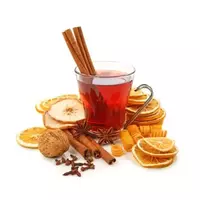Mulled wine

We think many have heard, and perhaps experienced the beneficial properties of mulled wine, an alcoholic drink served hot. Translated from German, the word Glühwein, which gave its name to the famous drink glentwein, means "hot or flaming wine. " So mulled wine is the case when the name speaks for itself.
Mulled wine composition
The mulled wine composition includes wine, which is preheated to a temperature of 80 degrees, and then spices and spices are added to alcohol. Interestingly, to make mulled wine steel "not fun for the sake of, " but to warm up in the cold winter conditions of the countries of Scandinavia. Especially in the old days, as in our time, Christmas and other festive open-air bazaars were incredibly popular.
At such events, the drink turned out to be very useful. The wine included in mulled wine warmed and amused with its hops, so the sellers and buyers in the winter markets felt just fine. The useful properties of mulled wine have long been appreciated by residents of countries such as Austria, Switzerland, the Czech Republic, Germany and others.
Nowadays, most restaurants, bars and other drinking establishments in Europe have a mulled wine drink on their menu. The calorie content of mulled wine depends on some factors. For example, from the choice of wine, which will become the basis of the drink. Connoisseurs and connoisseurs of mulled wine argue that red wine, no matter dry or semi-dry, is perfect for making a drink. Often, to increase the strength of mulled wine, rum or cognac is added to the wine.
There are also several options for preparing mulled wine: with or without water. The average calorie level of mulled wine is at 132 Kcal in 100 grams of drinks. However, do not forget that this indicator may change if you add a slightly larger amount of sugar to the drink.
The benefits of mulled wine
The benefit of mulled wine lies primarily in the excellent warming and invigorating properties of the drink. Mulled wine will help with colds, headaches, runny nose and temperature. It's all about the ingredients that are used to make real mulled wine. According to the recipe of the drink, you will need: cloves or cinnamon, honey, lemon zest, ginger, cardamom, pepper and bay leaf.
Agree, one look at the composition of the drink is enough to assess the benefits of mulled wine for the human body. In order to make mulled wine, take: dry or semi-dry red wine, spices and seasonings, as well as sugar or honey to give an additional sweetness to the drink. You need to pour the wine into a saucepan (you can dilute with water) and heat it to 80 degrees.
Remember, wine should not boil otherwise you will lose the taste and healthy properties of the drink. Add spices and spices to the hot wine, then honey or sugar and leave under a closed lid for 25-30 minutes. Mulled wine can be drunk immediately, but it is better to let the drink infuse, then all useful substances will be able to switch to the drink.
mulled wine 132 kCal
Energy value of mulled wine (Ratio of proteins, fats, carbohydrates - ju):
Proteins: 5.1 g (~ 20 kCal)
Fats: 0.9 g (~ 8 kCal)
Carbohydrates: 25.9 g (~ 104 kCal)
Energy ratio (bj | y): 15% | 6% | 78%
 Español
Español Français
Français Português
Português Русский
Русский 简体中文
简体中文 繁體中文
繁體中文 日本語
日本語 한국어
한국어 العربية
العربية Türkçe
Türkçe Қазақ
Қазақ Deutsch
Deutsch Italiano
Italiano Українська
Українська
